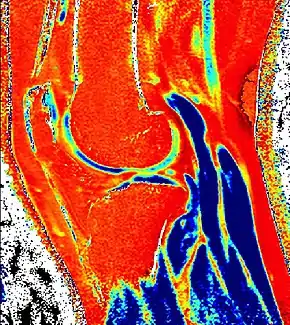Delayed gadolinium-enhanced magnetic resonance imaging of cartilage
Delayed gadolinium-enhanced magnetic resonance imaging of cartilage or dGEMRIC measures the fixed-charge density and relative proteoglycan content of articular cartilage using the spin-lattice relaxation time or T1 relaxation time.[1] Current research is investigating the clinical application of dGEMRIC as a quantitative tool for monitoring cartilage function in diseased or repair cartilage.[2]
| Delayed gadolinium-enhanced magnetic resonance imaging of cartilage | |
|---|---|
 dGEMRIC T1 Map of knee cartilage | |
| Purpose | measures relative proteoglycan content of articular cartilage |
References
- Bashir, A; Gray, ML; Boutin, RD; Burstein, D (Nov 1997). "Glycosaminoglycan in articular cartilage: in vivo assessment with delayed Gd(DTPA)(2-)-enhanced MR imaging". Radiology. 205 (2): 551–8. doi:10.1148/radiology.205.2.9356644. PMID 9356644.
- Siversson, C; Tiderius, CJ; Neuman, P; Dahlberg, L; Svensson, J (May 2010). "Repeatability of T1-quantification in dGEMRIC for three different acquisition techniques: two-dimensional inversion recovery, three-dimensional look locker, and three-dimensional variable flip angle". Journal of Magnetic Resonance Imaging. 31 (5): 1203–9. doi:10.1002/jmri.22159. PMID 20432357.
External links
- The Impact of the Relaxivity Definition on the Quantitative Measurement of Glycosaminoglycans in Cartilage by MRI dGEMRIC Method
- Delayed Gadolinium-enhanced MR Imaging of Articular Cartilage: Three-dimensional T1 Mapping with Variable Flip Angles and B1 Correction
- Toward Imaging Biomarkers for Glycosaminoglycans
- Longitudinal Evaluation of Cartilage Composition of Matrix-Associated Autologous Chondrocyte Transplants with 3-T Delayed Gadolinium-Enhanced MRI of Cartilage
- Association between findings on delayed gadolinium-enhanced magnetic resonance imaging of cartilage and future knee osteoarthritis
- Delayed Gadolinium-enhanced MR to Determine Glycosaminoglycan Concentration in Reparative Cartilage after Autologous Chondrocyte Implantation: Preliminary Results
- Glycosaminoglycan Distribution in Cartilage as Determined by Delayed Gadolinium-Enhanced MRI of Cartilage (dGEMRIC): Potential Clinical Applications
This article is issued from Wikipedia. The text is licensed under Creative Commons - Attribution - Sharealike. Additional terms may apply for the media files.